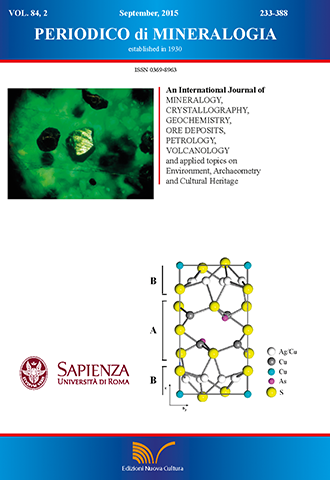Chemical and isotopic characterization of products of small-scale hypervelocity impacts: the Gebel Kamil event
DOI:
https://doi.org/10.2451/2015PM0016Keywords:
Impact Crater, Chemical data, 18O data,Abstract
This study presents chemical and oxygen isotope data on a series of materials found in the area of the Gebel Kamil crater, a recent well preserved impact crater in southern Egypt, which was formed by the explosive impact of a metal projectile. Intracrateric target rocks, fallback deposits, partially melted ejecta clasts (impactites) and recent or present-day aeolian sands have been considered. Exposed target material essentially represented by quartz arenites and minor beds of siltites resulted to be chemically and isotopically heterogeneous. The latter showed enrichment in lithophile elements (Al, K, Ba, REE, etc.) and 18O. Abundance of siderophile elements (Ni, Co, Cu) indicates that none of the exposed target rocks and recent aeolian sand deposits was contaminated by materials of the metal impactor. On the other hand, the same elements confirm the presence of projectile-derived components in all samples of fallback deposits and products of thermal metamorphism (ejecta melted clasts). Lithophile elements and isotope chemistry of the fallback deposit is intermediate between that of the two main target rocks. Light-coloured impactite clasts representing a minor (<10% vol.) component of the impact melted products are chemically and isotopically distinct from the dark-coloured impactites. The latter are enriched in lithophile elements and 18O also with respect to estimated “average” composition of the intracrateric target rocks. The distribution of siderophile elements in fallback deposits and impactites suggests that the metal projectile was directly involved in impact melting of terrestrial materials. A distinctive chemical and isotope signature of most of impact melted products, with respect to “average” composition of the exposed crater target rocks, poses problems concerning the actual terrestrial material source involved in impact thermal metamorphism. On the basis of knowledge relative to pre-impact surface geological stratigraphy, we hypothesize that most impactites were originated by melting of materials from an unconsolidated cover possibly enriched in siltite component with respect exposed target rocks and affected by weathering processes. The extreme variability in siderophile element ratios (e.g. Ni/Co, Ni/Cu, etc.) in fallback deposits and impactites suggests that extensive element fractionation occurs during the process of explosive disruption of an impactant body


